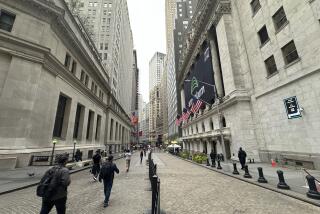Dow Index Back to Pre-Attack Level
Major stock indexes posted modest gains Friday as investors pondered what direction to take after the surge in stock prices this week. The Dow Jones industrial average closed above its pre-Sept. 11 level for the first time since the attacks.
“This is a market that’s recognizing that it’s come a long way in a relatively short period of time,” said Charles G. Crane, strategist for Victory SBSF Capital Management. “If you look at the major benchmarks, the Nasdaq’s up about 28% [since Sept. 11] and the S&P; is up nearly 16%. Those are impressive numbers.”
The Dow closed up 20.48 points, or 0.2%, at 9,608.00--just above its close of 9,605.51 on Sept. 10. The index has recouped the 1,369 points it lost in the ensuing sell-off.
Broader stock indicators advanced marginally. The Standard & Poor’s 500 index rose 1.77 points to 1,120.31, and the Nasdaq composite index gained less than a point to 1,828.48. Both surpassed pre-attack levels last month.
Although all three indexes finished in the black, declining issues led advancers by an 18-17 margin on Nasdaq. On the New York Stock Exchange, winners led losers by 16 to 15. Trading was light.
Friday’s trading appeared company-specific. Boeing lost $1.66 to $33.24 on news Scandinavian airline SAS had grounded 43 Boeing planes due to mechanical concerns.
Hewlett-Packard maintained its advance this week on news suggesting its plans to buy Compaq Computer were in jeopardy. HP rose 64 cents to $18.99, and Compaq lost 26 cents to $7.73.
Energy stocks rose on reports that OPEC members might agree to curtail supply to reverse the recent slide in oil prices. ExxonMobil rose 75 cents to $40.25.
The session was an uneventful end to a strong week in which the Nasdaq gained 4.7%, and the Dow and Nasdaq both rose 3.1%. Analysts attributed the advance to momentum from rallies Monday and Tuesday, which preceded and followed the Federal Reserve’s 10th interest rate cut this year.
The cuts also have helped stabilize a market in which good earnings and economic data remain scarce. Lower interest rates mean money market and other non-equity accounts pay smaller returns--giving investors a greater incentive to put money into the stock market.
Analysts said that right now, investors are hesitant to buy aggressively because economic data remain weak, particularly employment statistics that show job losses growing. As a result, some people have taken profits after big rallies rather than risk losing them should stocks fall again.
There is some concern about consumer spending, which accounts for two-thirds of the economy. However, a University of Michigan study released Friday that showed a slight improvement in consumer sentiment got little response from Wall Street.
Also Friday, the Labor Department reported that prices at the wholesale level plunged 1.6% in October, the biggest one-month drop in 54 years of record-keeping, as gasoline and energy prices fell by the largest amount in 12 years.
In other market highlights:
* Overseas markets slumped, led by a 2.1% drop in Japan. Markets in Germany, Britain and France all closed lower as Thursday’s interest rate cuts by key European central banks produced little follow-through.
* Oil prices jumped $1.05 to $22.22 a barrel, bringing their two-day gain to 10%. Oil field services stocks rose in tandem, with Baker Hughes gaining $1.11 to $37.24 and Schlumberger rising $1.49 to $49.74.
* Shares of Santa Ana-based Powerwave Technologies fell $1.16 to $16.11 after an analyst said the wireless networking component maker’s stock is expensive.
* Genentech gained $3.33 to $53.33. The biotech company said it plans to buy back $625 million worth of its common stock in the next 12 months. It has about 528 million shares outstanding.
*
Market Roundup, C4-5
More to Read
Inside the business of entertainment
The Wide Shot brings you news, analysis and insights on everything from streaming wars to production — and what it all means for the future.
You may occasionally receive promotional content from the Los Angeles Times.










